Parents; How to Talk to Your Children about The Oklahoma Tornado
“Hi Robyn; We’re fine. It missed us by 2 street blocks. We’re fine, our houses are fine. So sorry we weren’t able to call or text during the storm. We love you guys.”

In the recent past, I’ve written articles about how to talk to children about horrifying events such as the SandyHook, Connecticut shooting and The Boston Marathon bombing. In both articles, while incredibly concerned, I was not touched personally by the tragedies. I had lived in Boston for many years (I received my PhD from Tufts University near Boston) and made many friends there—but nobody I knew had attended the marathon and all were perfectly safe during the tragedy.
Yesterday, a massive tornado hit Moore, OK. I couldn’t believe it when I saw the name in the news. Moore? I have a deep personal tie to Moore. Both my children were born there. Both of their adoptions took place in Moore. And most significantly, the birth family of both my children still live in Moore. Their birth mother, their birth father and their birth grandmother.
Many of you who are constant, devoted readers of my parenting site know that we have an open adoption plan with my children’s birth family. This is not just on paper. We are extremely close with the birth family—so much so that none of us regard each other as “birth family” and “adoptive family” (I only use those names here to avoid confusion)—we just call each other family.
I am so happy to report that our family members in Moore are all safe. The message on the top of this article was left by our children’s birth grandmother. We have been in contact over the last 2 days and while our whole family had quite a scare, they got out of the storm unscathed. The tornado passed 2 miles away from my kids’ birth father’s house and a ¼ mile from his girlfriend’s place of work. He was holed up in a bank vault for safety while my kids’ birth mother took refuge in a Walmart with a hundred other people. The kids’ birth grandmother literally drove herself away from the oncoming storm. The whole thing is beyond scary.
The experience has given me a more nuanced perspective of how to talk to children about frightening events such as this tornado in Oklahoma. Since my children (especially my 4 year old) know about the storm and how it affected our family, it is from this perspective that I write my tips today.
(1) Ensure your children know that this tornado is not a threat to their safety: “Is the tornado coming here” my daughter wondered? Sometimes just saying; “no, it’s all done” is enough. Other times, for the very curious child, this may be a good for a little weather lesson. You can say; “Just like a speed bump in the road slows down cars, most people believe that something gets in the way of tornadoes making them slow down until they are no longer tornadoes anymore. That’s what happened to this tornado! So no, it’s all done. The tornado is not coming here.”
(2) Listen to their fears: Parents often want to “fix the fear” or diminish the importance of it as soon as possible. Take a moment to listen instead. It is valid that your children may be scared. Ask questions like “What is scaring you?” and “What might make you feel better?” Reflect their concerns by saying: “Yes; it’s scary to hear that the tornado hurt some people” or “I get the feeling that you are worried about tornadoes coming to our town.” Steer clear of saying; “Don’t be scared” or “Stop worrying so much” as it invalidates their emotions—which are quite real.
(3) Turn off the news: Make sure the information your children are learning is from you rather than from the TV. The news can be very graphic and not at all age-appropriate. While you may want to keep posted on what’s going on, do it privately rather than in front of your children.
(4) Let them know about the positive stories: This morning I heard about a teacher who kept her students safe in the school while the tornado came through town. Tell your children about that. There have been reports that, through his family foundation, Oklahoma City Thunder star Kevin Durant pledged $1 million to the American Red Cross disaster relief efforts in Oklahoma. Tell your children about that. This morning it was reported that the OK Highway Patrol confirms that 101 people were found alive in Moore overnight. Tell your children about that. In this tragedy, there was good news—and children need to know about these stories. There are a lot of helpers and we are so grateful.
(5) Encourage them to do something to help: My daughter is only four and my son is just shy of three—but that doesn’t mean they can’t do anything to help. They can write letters, draw pictures and may even be able to help donate items needed. But perhaps their voices of love may be the kindest thing to provide. We had our daughter call her birth mother, her birth father and her birth grandmother and leave a message on their phones (getting through is still tricky). She was able to say; “Hi, I love you and I’m so glad you’re safe.” The act of “doing” can be very reassuring for a young person. Actually, it can be very reassuring for all of us!
During all of this—stay calm. Our children absorb the emotion we release. That doesn’t mean we need to be stoic or happy—it just means that we should leave the heavy burden of our feelings to our peers and our adult loved ones. You can say; “I’m sad for all the people in Oklahoma who are having a tough time right now because of the tornado. I wish it didn’t happen.”
Because really; don’t we all feel that way?



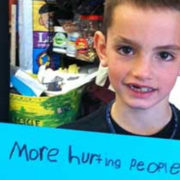
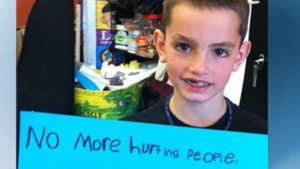 As we now all know, yesterday’s tragic bombing at the Boston Marathon resulted in at least 176 people injured.
As we now all know, yesterday’s tragic bombing at the Boston Marathon resulted in at least 176 people injured.  good people
good people that they can contribute to their family, their community, their country and beyond. Encourage them to do that. By doing so, you will teach them that there is a lot more good in this world than there is evil. And, yes, they are a big part of that good.
that they can contribute to their family, their community, their country and beyond. Encourage them to do that. By doing so, you will teach them that there is a lot more good in this world than there is evil. And, yes, they are a big part of that good.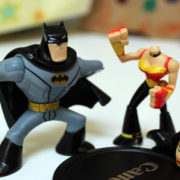
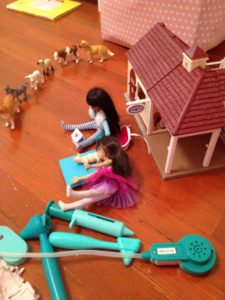 As a parent, I often wonder about how the toys and role models in my children’s lives translate to behavior. I tend to be the kind of mother who encourages a wide range of toys, games and books. I am less about banning (unless it is truly counter to our family’s core character-based values) and more about providing a continuum of options so that my children gain experience, choice and understanding.
As a parent, I often wonder about how the toys and role models in my children’s lives translate to behavior. I tend to be the kind of mother who encourages a wide range of toys, games and books. I am less about banning (unless it is truly counter to our family’s core character-based values) and more about providing a continuum of options so that my children gain experience, choice and understanding. My daughter has been known to “acquire” my son’s Batman figure as well as his Spiderman book. She asked for a Superhero book of her own for her most recent birthday that features Superman, Batman and Wonder Woman all together. She’s even going as Wonder Woman to a Superhero/Princess birthday party this weekend. When I asked Tallie what she likes about Wonder Woman, she told me; “She’s cool! She fights cwime!” Justice. Power. Self reliance. Good for every gender!
My daughter has been known to “acquire” my son’s Batman figure as well as his Spiderman book. She asked for a Superhero book of her own for her most recent birthday that features Superman, Batman and Wonder Woman all together. She’s even going as Wonder Woman to a Superhero/Princess birthday party this weekend. When I asked Tallie what she likes about Wonder Woman, she told me; “She’s cool! She fights cwime!” Justice. Power. Self reliance. Good for every gender!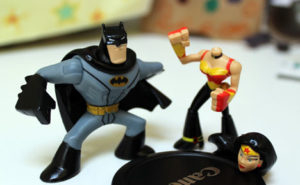 This morning, Wonder Woman single-handedly stopped an oncoming train from crashing into the building of blocks that we all built together– and Batman rescued the people off the train. Unfortunately, there was a casualty. The Wonder Woman action figure was decapitated. Who makes a Superhero with such a flimsy neck? She’s an Amazon Princess Warrior for cripes sake– not a runway model! Ah, well, off to the store to invest in a Wonder Woman toy that can hold her ground…and keep up with my kids!
This morning, Wonder Woman single-handedly stopped an oncoming train from crashing into the building of blocks that we all built together– and Batman rescued the people off the train. Unfortunately, there was a casualty. The Wonder Woman action figure was decapitated. Who makes a Superhero with such a flimsy neck? She’s an Amazon Princess Warrior for cripes sake– not a runway model! Ah, well, off to the store to invest in a Wonder Woman toy that can hold her ground…and keep up with my kids!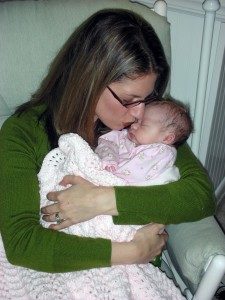 Believe me. This was not what I had envisioned when I thought about pregnancy for myself. I was more of a traditional gal—thinking that the whole baby- boarding process would actually be taking place in my own body. You know—baby bump, bloated feet, morning sickness–the whole enchilada. I certainly hadn’t considered the possibility of pregnancy being an out-of-body experience.
Believe me. This was not what I had envisioned when I thought about pregnancy for myself. I was more of a traditional gal—thinking that the whole baby- boarding process would actually be taking place in my own body. You know—baby bump, bloated feet, morning sickness–the whole enchilada. I certainly hadn’t considered the possibility of pregnancy being an out-of-body experience.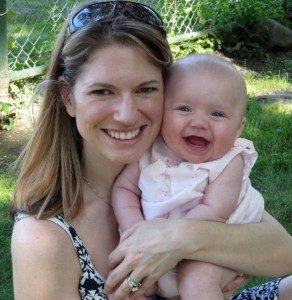 As you can probably imagine, I felt like the shoemaker’s daughter. I didn’t just work with children and families, I provided parenting tips and tactics to moms and dads around the world…all the while housing a secret that taunted and tortured me every day. I couldn’t get pregnant. Well, that’s not exactly true. I was pretty good at getting pregnant. I just couldn’t seem to stay that way.
As you can probably imagine, I felt like the shoemaker’s daughter. I didn’t just work with children and families, I provided parenting tips and tactics to moms and dads around the world…all the while housing a secret that taunted and tortured me every day. I couldn’t get pregnant. Well, that’s not exactly true. I was pretty good at getting pregnant. I just couldn’t seem to stay that way.
 The first thing my daughter, Tallie, wanted to do this morning was go downstairs and have me read her two Spiderman stories from her brother’s new Adventures of Spiderman book he received for Hanukkah last night. So that’s what I did. It was from that book that I read her a good night story before bed last night (because nothing says sleep like Spidey against “Lizardman”). She has also taken a liking to her brother’s new Hess helicopter and truck (so we got her one too that she’ll get for Hanukkah one night).
The first thing my daughter, Tallie, wanted to do this morning was go downstairs and have me read her two Spiderman stories from her brother’s new Adventures of Spiderman book he received for Hanukkah last night. So that’s what I did. It was from that book that I read her a good night story before bed last night (because nothing says sleep like Spidey against “Lizardman”). She has also taken a liking to her brother’s new Hess helicopter and truck (so we got her one too that she’ll get for Hanukkah one night). As parents we must be careful. Society tells us that girls are meant to love princesses and pink—and some of them do—but not all of them—and for those who do, that’s not all they love. And it’s vital to our girls’ healthy development that we nurture all sides of them.
As parents we must be careful. Society tells us that girls are meant to love princesses and pink—and some of them do—but not all of them—and for those who do, that’s not all they love. And it’s vital to our girls’ healthy development that we nurture all sides of them. On Sunday morning, Tallie, dressed in her “Dora the Explorer” nightgown, sequestered herself in her room, playing with her “animal hospital” she helped build with her Daddy the night before. On line to be “checked out” were several horses, a tiny kitten, a goat, a sheep and an alien. At the “reception desk” was one of the new “Lottie dolls” dressed in a blue sparkly shirt and a faux fur vest while another Lottie doll, dressed in a frilly purple dance dress, played nurse to her “Dr. Tallie.”
On Sunday morning, Tallie, dressed in her “Dora the Explorer” nightgown, sequestered herself in her room, playing with her “animal hospital” she helped build with her Daddy the night before. On line to be “checked out” were several horses, a tiny kitten, a goat, a sheep and an alien. At the “reception desk” was one of the new “Lottie dolls” dressed in a blue sparkly shirt and a faux fur vest while another Lottie doll, dressed in a frilly purple dance dress, played nurse to her “Dr. Tallie.” My hope is that we all open our hearts and our homes to those who are still in need. Do what you can even if it’s small– donate, lend out generators or extension cords, invite people over for dinner and to stay the night. That’s been our plan of action as our power has been restored (thankfully) and we only had 2 fallen trees and some fence damage. We consider ourselves very lucky– and hope for the safety and quick recovery of those still dealing with the aftermath of Hurricane Sandy.
My hope is that we all open our hearts and our homes to those who are still in need. Do what you can even if it’s small– donate, lend out generators or extension cords, invite people over for dinner and to stay the night. That’s been our plan of action as our power has been restored (thankfully) and we only had 2 fallen trees and some fence damage. We consider ourselves very lucky– and hope for the safety and quick recovery of those still dealing with the aftermath of Hurricane Sandy.